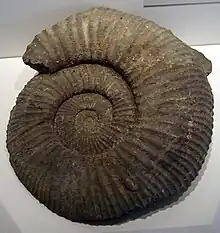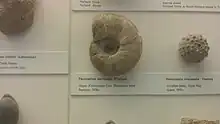| Pectinatites Temporal range: Tithonian, | |
|---|---|
 | |
| P. groenlandicus in Geological Museum, Copenhagen | |
| Scientific classification | |
| Kingdom: | |
| Phylum: | |
| Class: | |
| Order: | |
| Genus: | Pectinatites Arkell (1947) |
| Species[2] | |
| |

P. pectinatus from Kimmeridge Clay Formation, Swindon, Wiltshire, England at the Natural History Museum
Pectinatites is an extinct cephalopod genus belonging to the order Ammonoidea, that lived during the upper Tithonian stage of the Late Jurassic.[1] They were fast-moving nektonic carnivores.[2]
Clutches of eggs attributed to this genus have been discovered in the Kimmeridge Clay.[3]
References
- Notes
- 1 2 Sepkoski, Jack (2002). "Sepkoski's Online Genus Database". Retrieved 2014-05-28.
- 1 2 "Paleobiology Database - Pectinatites". Retrieved 17 December 2021.
- ↑ Etches, S.; Clarke, J.; Callomon, J. (2009). "Ammonite eggs and ammonitellae from the Kimmeridge Clay Formation (Upper Jurassic) of Dorset, England". Lethaia. 42 (2): 204–217. doi:10.1111/j.1502-3931.2008.00133.x.
- Weblinks
This article is issued from Wikipedia. The text is licensed under Creative Commons - Attribution - Sharealike. Additional terms may apply for the media files.